LINCOLN MKZ 2014 Owners Manual
Manufacturer: LINCOLN, Model Year: 2014, Model line: MKZ, Model: LINCOLN MKZ 2014Pages: 468, PDF Size: 4.49 MB
Page 171 of 468
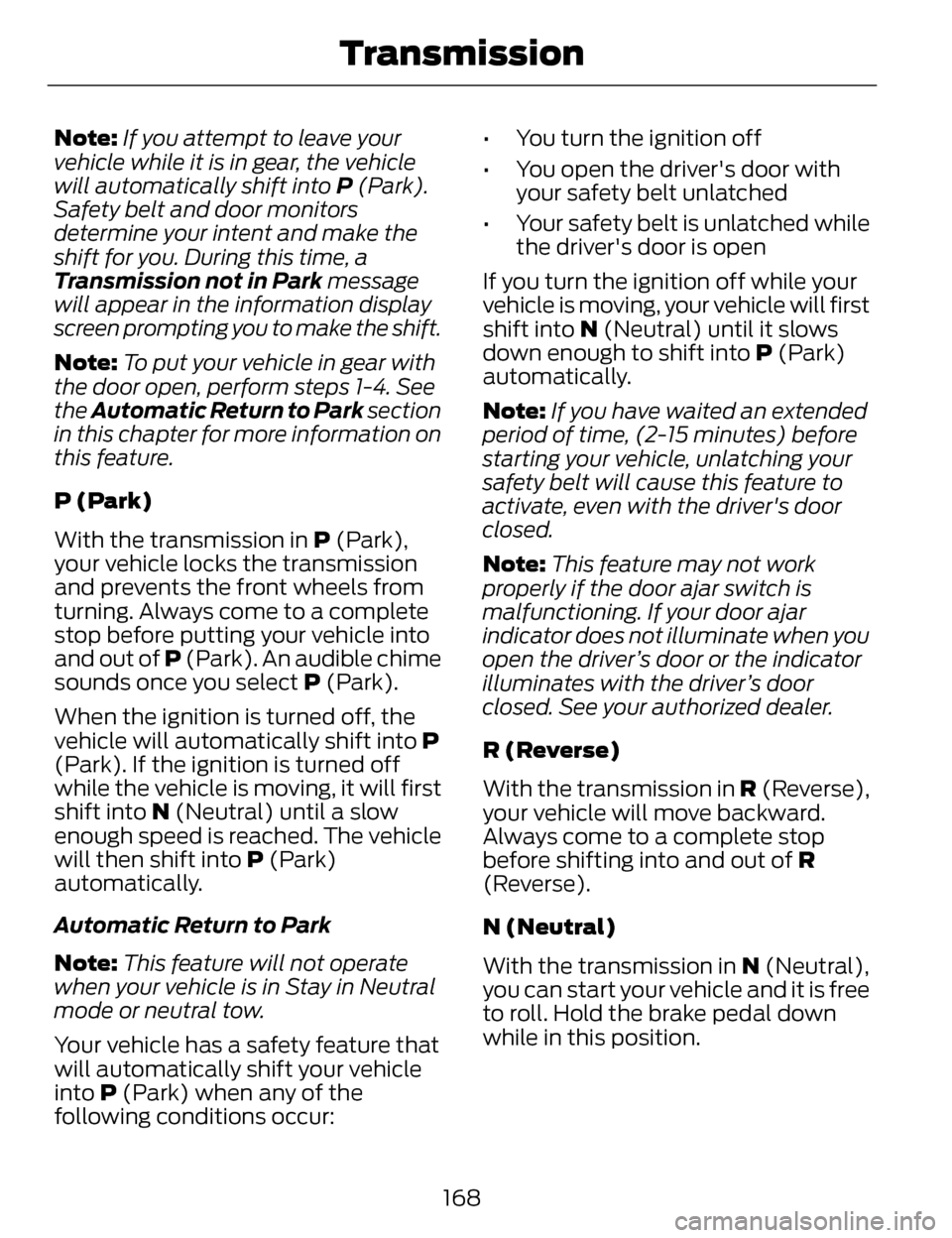
Note:If you attempt to leave your
vehicle while it is in gear, the vehicle
will automatically shift into P (Park).
Safety belt and door monitors
determine your intent and make the
shift for you. During this time, a
Transmission not in Park message
will appear in the information display
screen prompting you to make the shift.
Note: To put your vehicle in gear with
the door open, perform steps 1-4. See
the Automatic Return to Park section
in this chapter for more information on
this feature.
P (Park)
With the transmission in P (Park),
your vehicle locks the transmission
and prevents the front wheels from
turning. Always come to a complete
stop before putting your vehicle into
and out of P (Park). An audible chime
sounds once you select P (Park).
When the ignition is turned off, the
vehicle will automatically shift into P
(Park). If the ignition is turned off
while the vehicle is moving, it will first
shift into N (Neutral) until a slow
enough speed is reached. The vehicle
will then shift into P (Park)
automatically.
Automatic Return to Park
Note: This feature will not operate
when your vehicle is in Stay in Neutral
mode or neutral tow.
Your vehicle has a safety feature that
will automatically shift your vehicle
into P (Park) when any of the
following conditions occur: • You turn the ignition off
• You open the driver's door with
your safety belt unlatched
• Your safety belt is unlatched while the driver's door is open
If you turn the ignition off while your
vehicle is moving, your vehicle will first
shift into N (Neutral) until it slows
down enough to shift into P (Park)
automatically.
Note: If you have waited an extended
period of time, (2-15 minutes) before
starting your vehicle, unlatching your
safety belt will cause this feature to
activate, even with the driver's door
closed.
Note: This feature may not work
properly if the door ajar switch is
malfunctioning. If your door ajar
indicator does not illuminate when you
open the driver’s door or the indicator
illuminates with the driver’s door
closed. See your authorized dealer.
R (Reverse)
With the transmission in R (Reverse),
your vehicle will move backward.
Always come to a complete stop
before shifting into and out of R
(Reverse).
N (Neutral)
With the transmission in N (Neutral),
you can start your vehicle and it is free
to roll. Hold the brake pedal down
while in this position.
168
Transmission
Page 172 of 468
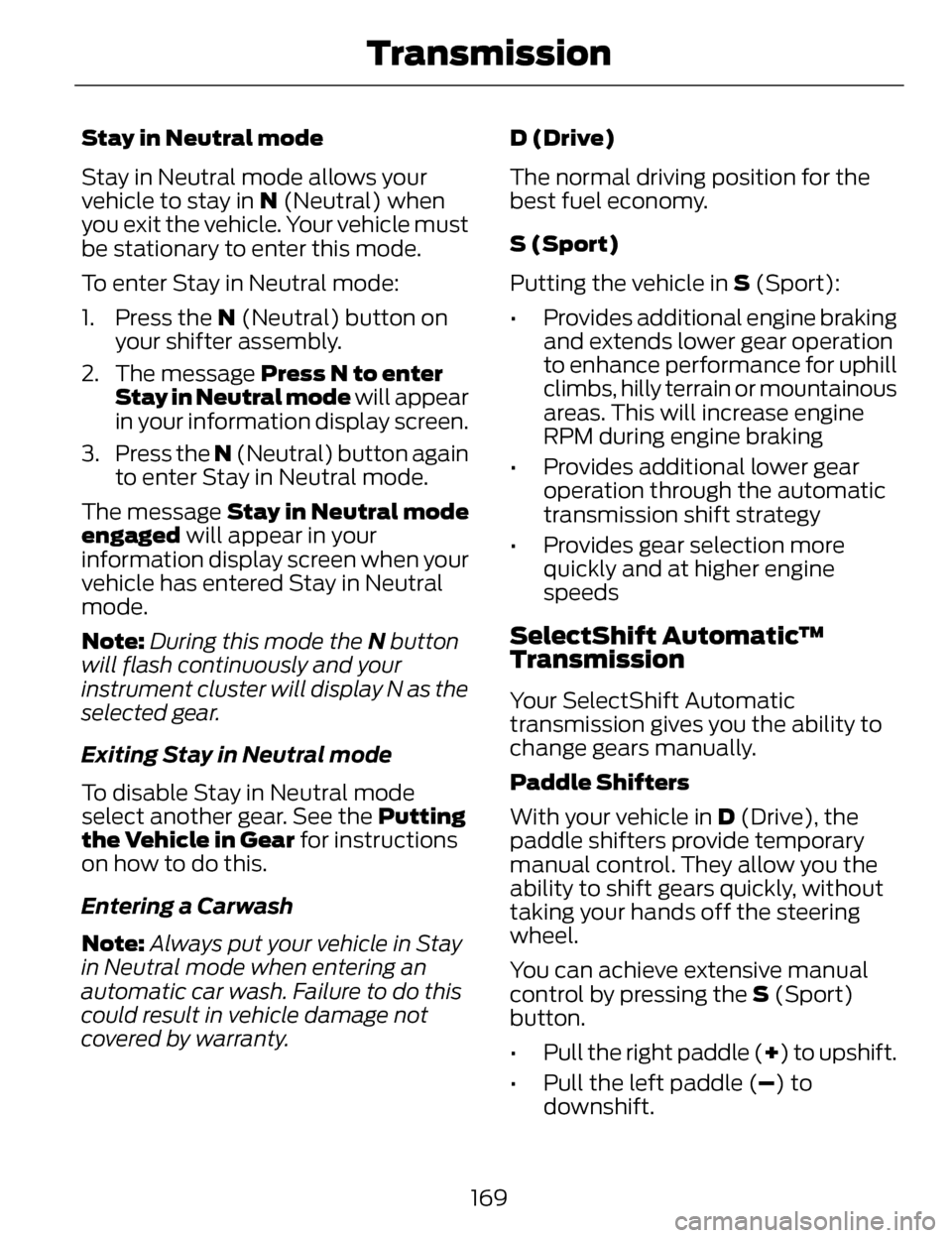
Stay in Neutral mode
Stay in Neutral mode allows your
vehicle to stay in N (Neutral) when
you exit the vehicle. Your vehicle must
be stationary to enter this mode.
To enter Stay in Neutral mode:
1. Press the N (Neutral) button onyour shifter assembly.
2. The message Press N to enter Stay in Neutral mode will appear
in your information display screen.
3. Press the N (Neutral) button again
to enter Stay in Neutral mode.
The message Stay in Neutral mode
engaged will appear in your
information display screen when your
vehicle has entered Stay in Neutral
mode.
Note: During this mode the N button
will flash continuously and your
instrument cluster will display N as the
selected gear.
Exiting Stay in Neutral mode
To disable Stay in Neutral mode
select another gear. See the Putting
the Vehicle in Gear for instructions
on how to do this.
Entering a Carwash
Note: Always put your vehicle in Stay
in Neutral mode when entering an
automatic car wash. Failure to do this
could result in vehicle damage not
covered by warranty. D (Drive)
The normal driving position for the
best fuel economy.
S (Sport)
Putting the vehicle in S (Sport):
• Provides additional engine braking
and extends lower gear operation
to enhance performance for uphill
climbs, hilly terrain or mountainous
areas. This will increase engine
RPM during engine braking
• Provides additional lower gear operation through the automatic
transmission shift strategy
• Provides gear selection more quickly and at higher engine
speeds
SelectShift Automatic™
Transmission
Your SelectShift Automatic
transmission gives you the ability to
change gears manually.
Paddle Shifters
With your vehicle in D (Drive), the
paddle shifters provide temporary
manual control. They allow you the
ability to shift gears quickly, without
taking your hands off the steering
wheel.
You can achieve extensive manual
control by pressing the S (Sport)
button.
• Pull the right paddle ( +) to upshift.
• Pull the left paddle ( –) to
downshift.
169
Transmission
Page 173 of 468
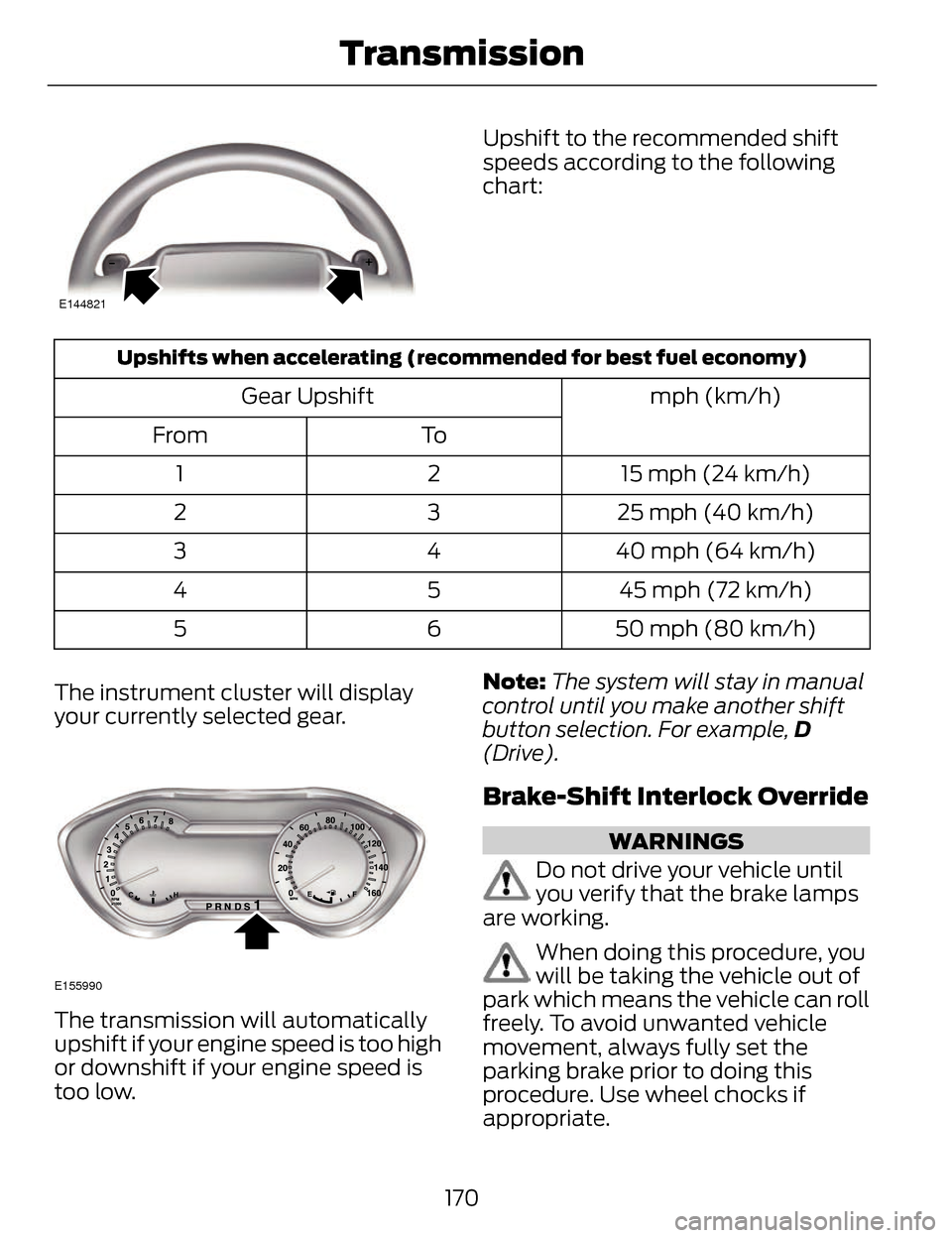
E144821
Upshift to the recommended shift
speeds according to the following
chart:
Upshifts when accelerating (recommended for best fuel economy)
mph (km/h)
Gear Upshift
To
From
15 mph (24 km/h)
2
1
25 mph (40 km/h)
3
2
40 mph (64 km/h)
4
3
45 mph (72 km/h)
5
4
50 mph (80 km/h)
6
5
The instrument cluster will display
your currently selected gear.
E155990
The transmission will automatically
upshift if your engine speed is too high
or downshift if your engine speed is
too low. Note:
The system will stay in manual
control until you make another shift
button selection. For example, D
(Drive).
Brake-Shift Interlock Override
WARNINGS
Do not drive your vehicle until
you verify that the brake lamps
are working.
When doing this procedure, you
will be taking the vehicle out of
park which means the vehicle can roll
freely. To avoid unwanted vehicle
movement, always fully set the
parking brake prior to doing this
procedure. Use wheel chocks if
appropriate.
170
Transmission
Page 174 of 468
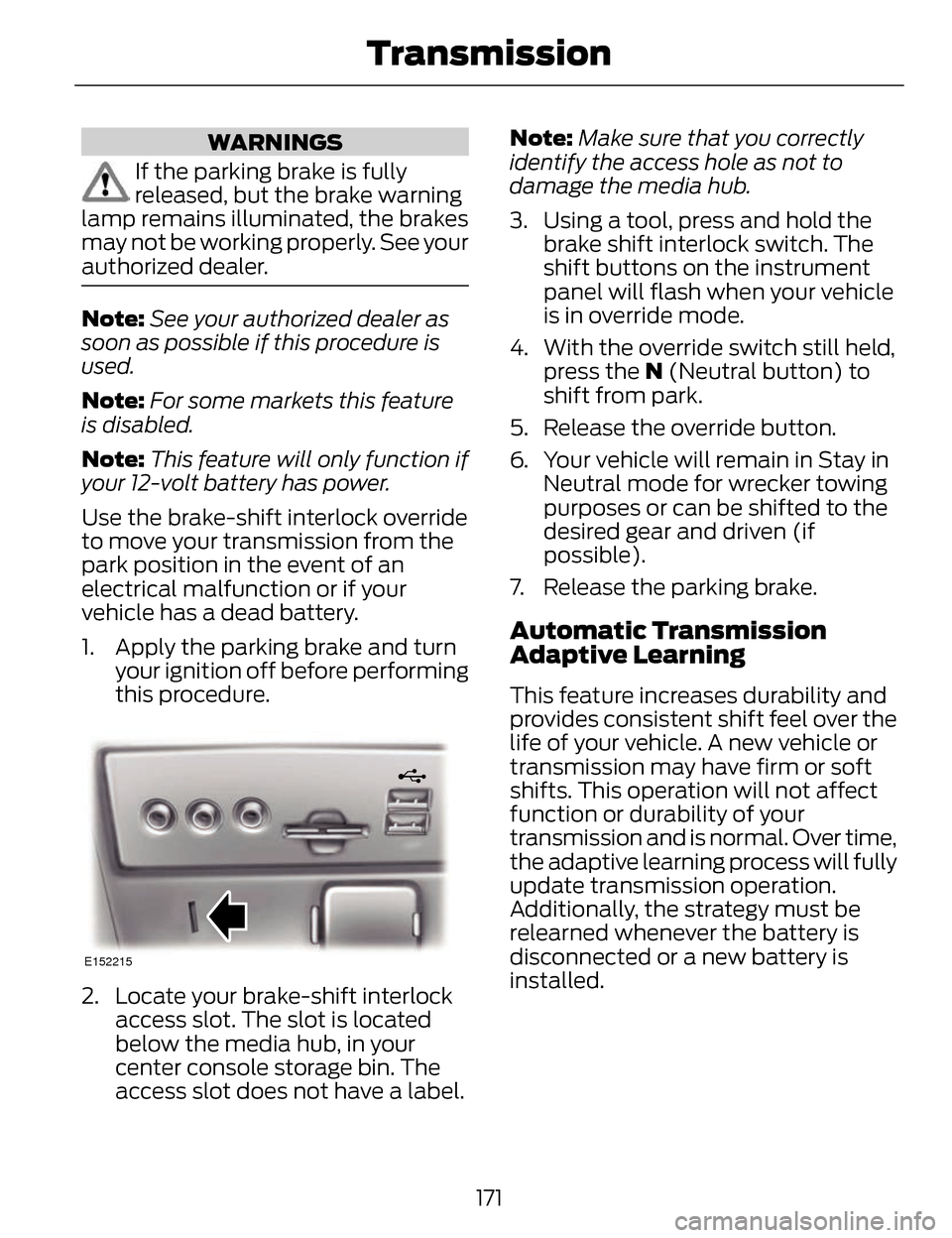
WARNINGS
If the parking brake is fully
released, but the brake warning
lamp remains illuminated, the brakes
may not be working properly. See your
authorized dealer.
Note: See your authorized dealer as
soon as possible if this procedure is
used.
Note: For some markets this feature
is disabled.
Note: This feature will only function if
your 12-volt battery has power.
Use the brake-shift interlock override
to move your transmission from the
park position in the event of an
electrical malfunction or if your
vehicle has a dead battery.
1. Apply the parking brake and turn your ignition off before performing
this procedure.
E152215
2. Locate your brake-shift interlockaccess slot. The slot is located
below the media hub, in your
center console storage bin. The
access slot does not have a label. Note:
Make sure that you correctly
identify the access hole as not to
damage the media hub.
3. Using a tool, press and hold the brake shift interlock switch. The
shift buttons on the instrument
panel will flash when your vehicle
is in override mode.
4. With the override switch still held, press the N (Neutral button) to
shift from park.
5. Release the override button.
6. Your vehicle will remain in Stay in Neutral mode for wrecker towing
purposes or can be shifted to the
desired gear and driven (if
possible).
7. Release the parking brake.
Automatic Transmission
Adaptive Learning
This feature increases durability and
provides consistent shift feel over the
life of your vehicle. A new vehicle or
transmission may have firm or soft
shifts. This operation will not affect
function or durability of your
transmission and is normal. Over time,
the adaptive learning process will fully
update transmission operation.
Additionally, the strategy must be
relearned whenever the battery is
disconnected or a new battery is
installed.
171
Transmission
Page 175 of 468
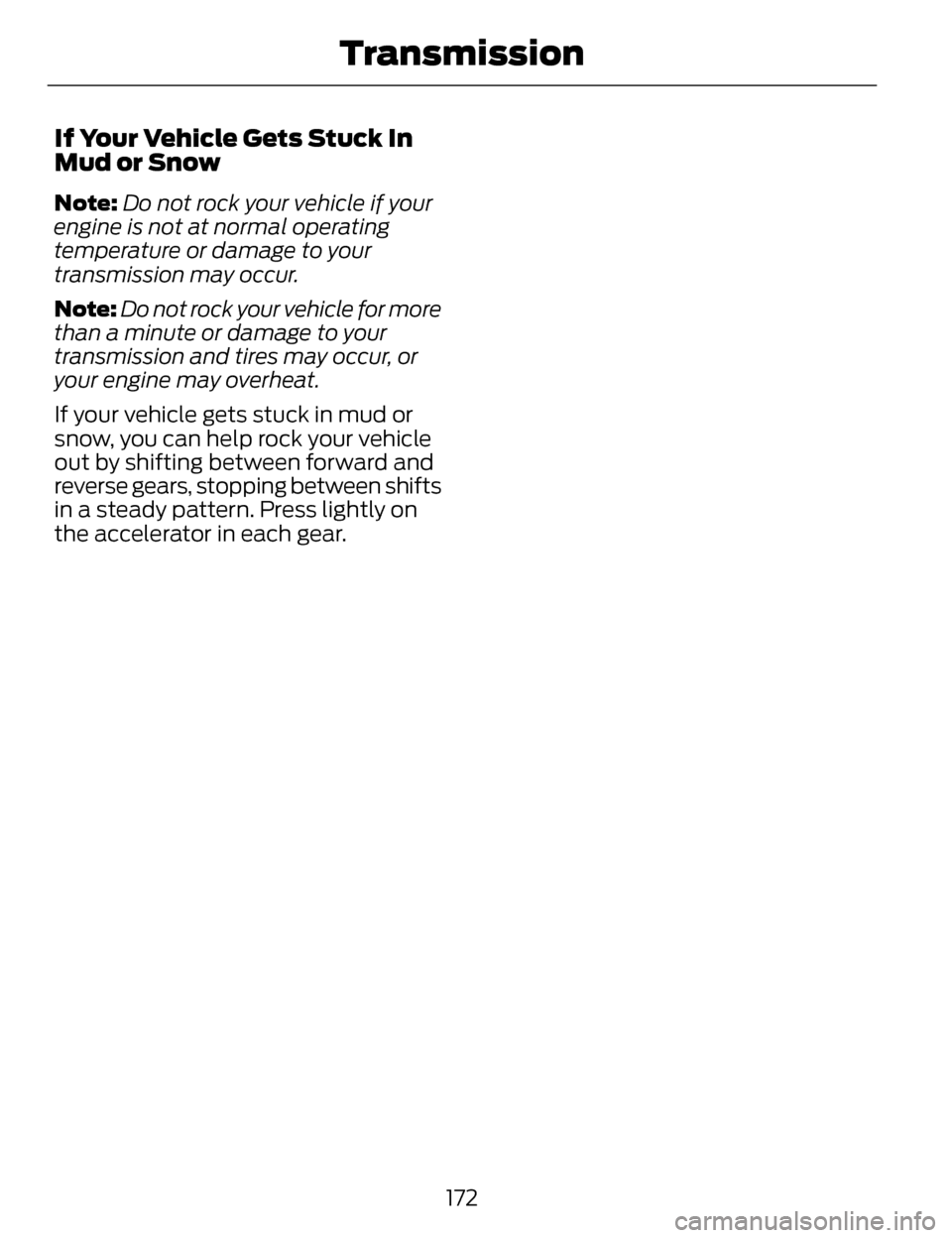
If Your Vehicle Gets Stuck In
Mud or Snow
Note:Do not rock your vehicle if your
engine is not at normal operating
temperature or damage to your
transmission may occur.
Note: Do not rock your vehicle for more
than a minute or damage to your
transmission and tires may occur, or
your engine may overheat.
If your vehicle gets stuck in mud or
snow, you can help rock your vehicle
out by shifting between forward and
reverse gears, stopping between shifts
in a steady pattern. Press lightly on
the accelerator in each gear.
172
Transmission
Page 176 of 468

USING ALL-WHEEL DRIVE
All-wheel drive uses all four wheels
to power the vehicle. This increases
traction, enabling you to drive over
terrain and road conditions that a
conventional two-wheel drive vehicle
cannot. The AWD system is active all
the time and requires no input from
the operator.
Note:Your AWD vehicle is not
intended for off-road use. The AWD
feature gives your vehicle some limited
off-road capabilities in which driving
surfaces are relatively level,
obstruction-free and otherwise similar
to normal on-road driving conditions.
Operating your vehicle under other than
those conditions could subject the
vehicle to excessive stress which might
result in damage which is not covered
under your warranty.
Note: A warning message will be
displayed in the information display
when an AWD system fault is present
See Information Messages (page 106).
An AWD system fault will cause the
AWD system to default to front-wheel
drive only mode. When this warning
message is displayed, have your vehicle
serviced at an authorized dealer Note:
A warning message will be
displayed in the information display if
the AWD system has overheated See
Information Messages (page 106).
This condition may occur if the vehicle
was operated in extreme conditions
with excessive wheel slip, such as deep
sand. To resume normal AWD function
as soon as possible, stop the vehicle in
a safe location and stop the engine for
at least 10 minutes. After the engine
has been restarted and the AWD
system has adequately cooled, the
warning message will turn off and
normal AWD function will return.
Do not use a spare tire of a different
size other than the tire provided. If the
mini-spare tire is installed, the AWD
system may disable automatically
and enter front-wheel drive only mode
to protect driveline components. This
condition will be indicated by a
warning in the information display
See Information Messages (page
106). If there is a warning message in
the information display from using the
spare tire, this indicator should turn
off after reinstalling the repaired or
replaced normal road tire and cycling
the ignition off and on. It is
recommended to reinstall the repaired
or replaced road tire as soon as
possible. Major dissimilar tire sizes
between the front and rear axles
could cause the AWD system to stop
functioning and default to front-wheel
drive or damage the AWD system.
173
All-Wheel Drive (If Equipped)
Page 177 of 468
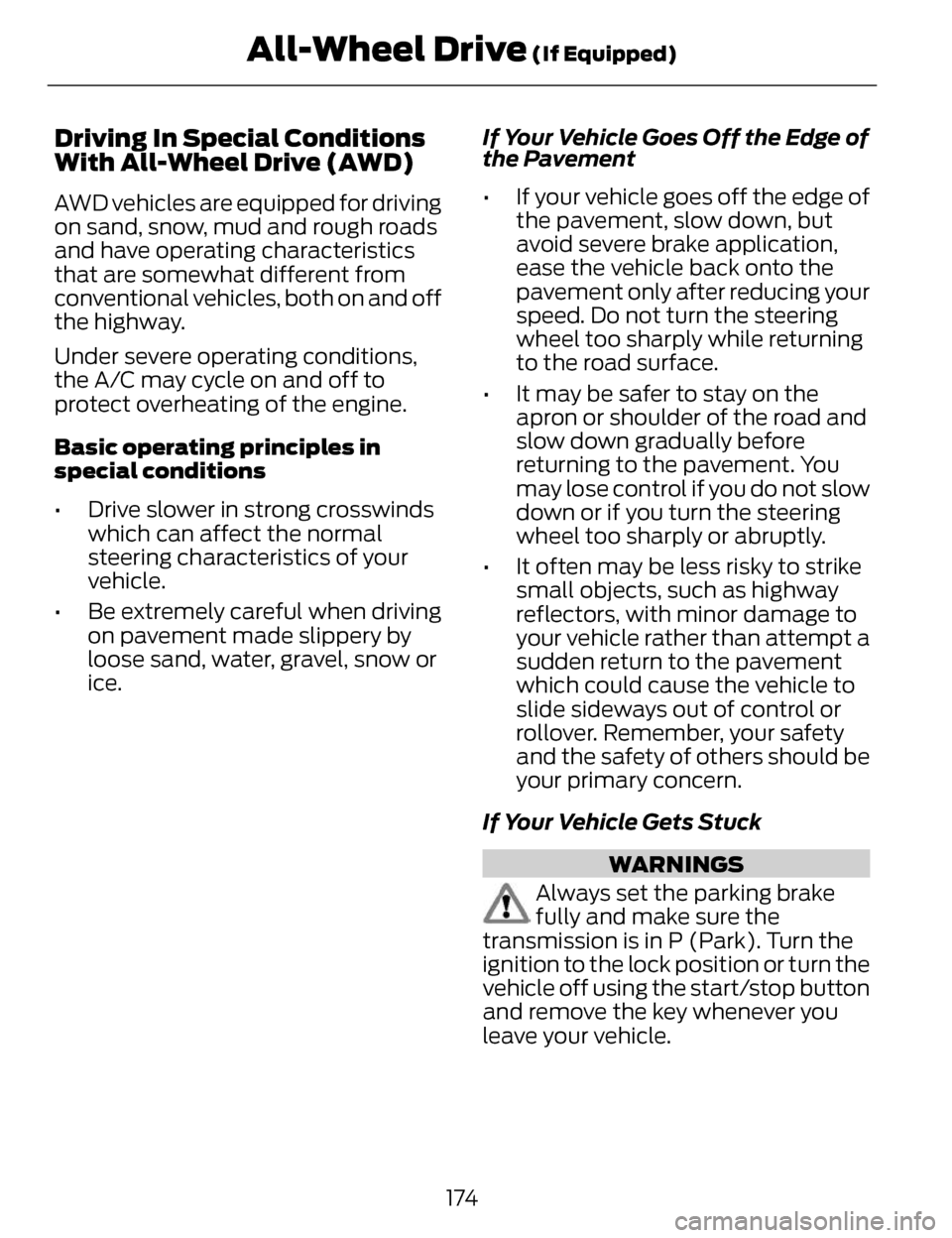
Driving In Special Conditions
With All-Wheel Drive (AWD)
AWD vehicles are equipped for driving
on sand, snow, mud and rough roads
and have operating characteristics
that are somewhat different from
conventional vehicles, both on and off
the highway.
Under severe operating conditions,
the A/C may cycle on and off to
protect overheating of the engine.
Basic operating principles in
special conditions
• Drive slower in strong crosswindswhich can affect the normal
steering characteristics of your
vehicle.
• Be extremely careful when driving on pavement made slippery by
loose sand, water, gravel, snow or
ice. If Your Vehicle Goes Off the Edge of
the Pavement
• If your vehicle goes off the edge of
the pavement, slow down, but
avoid severe brake application,
ease the vehicle back onto the
pavement only after reducing your
speed. Do not turn the steering
wheel too sharply while returning
to the road surface.
• It may be safer to stay on the apron or shoulder of the road and
slow down gradually before
returning to the pavement. You
may lose control if you do not slow
down or if you turn the steering
wheel too sharply or abruptly.
• It often may be less risky to strike small objects, such as highway
reflectors, with minor damage to
your vehicle rather than attempt a
sudden return to the pavement
which could cause the vehicle to
slide sideways out of control or
rollover. Remember, your safety
and the safety of others should be
your primary concern.
If Your Vehicle Gets Stuck
WARNINGS
Always set the parking brake
fully and make sure the
transmission is in P (Park). Turn the
ignition to the lock position or turn the
vehicle off using the start/stop button
and remove the key whenever you
leave your vehicle.
174
All-Wheel Drive (If Equipped)
Page 178 of 468

WARNINGS
If the parking brake is fully
released, but the brake warning
lamp remains illuminated, the brakes
may not be working properly. See your
authorized dealer.
Do not spin the wheels at over
35 mph (56 km/h). The tires may
fail and injure a passenger or
bystander.
Note: Do not rock the vehicle if the
engine is not at normal operating
temperature or damage to the
transmission may occur.
Note: Do not rock the vehicle for more
than a few minutes or damage to the
transmission and tires may occur or the
engine may overheat.
If your vehicle gets stuck in mud or
snow it may be rocked out by shifting
between forward and reverse gears,
stopping between shifts, in a steady
pattern. Press lightly on the
accelerator in each gear.
If your vehicle is equipped with
AdvanceTrac® with Roll Stability
Control™, it may be beneficial to
disengage the AdvanceTrac® with
Roll Stability Control™ system while
attempting to rock the vehicle.
Emergency Maneuvers
• In an unavoidable emergency situation where a sudden sharp
turn must be made, remember to
avoid "over-driving" your vehicle
(i.e., turn the steering wheel only
as rapidly and as far as required to
avoid the emergency). Excessive steering will result in less vehicle
control, not more. Additionally,
smooth variations of the
accelerator and/or brake pedal
pressure should be utilized if
changes in vehicle speed are called
for. Avoid abrupt steering,
acceleration or braking which
could result in an increased risk of
loss of vehicle control, vehicle
rollover and/or personal injury. Use
all available road surface to return
the vehicle to a safe direction of
travel.
• In the event of an emergency stop, avoid skidding the tires and do not
attempt any sharp steering wheel
movements.
• If the vehicle goes from one type of surface to another (i.e., from
concrete to gravel) there will be a
change in the way the vehicle
responds to a maneuver (steering,
acceleration or braking). Again,
avoid these abrupt inputs.
Sand
When driving over sand, try to keep all
four wheels on the most solid area of
the trail. Avoid reducing the tire
pressures but shift to a lower gear and
drive steadily through the terrain.
Apply the accelerator slowly and
avoid spinning the wheels.
Do not drive your AWD vehicle in deep
sand. This will cause the AWD system
to overheat. After the system has
cooled down, normal AWD function
will return.
175
All-Wheel Drive (If Equipped)
Page 179 of 468
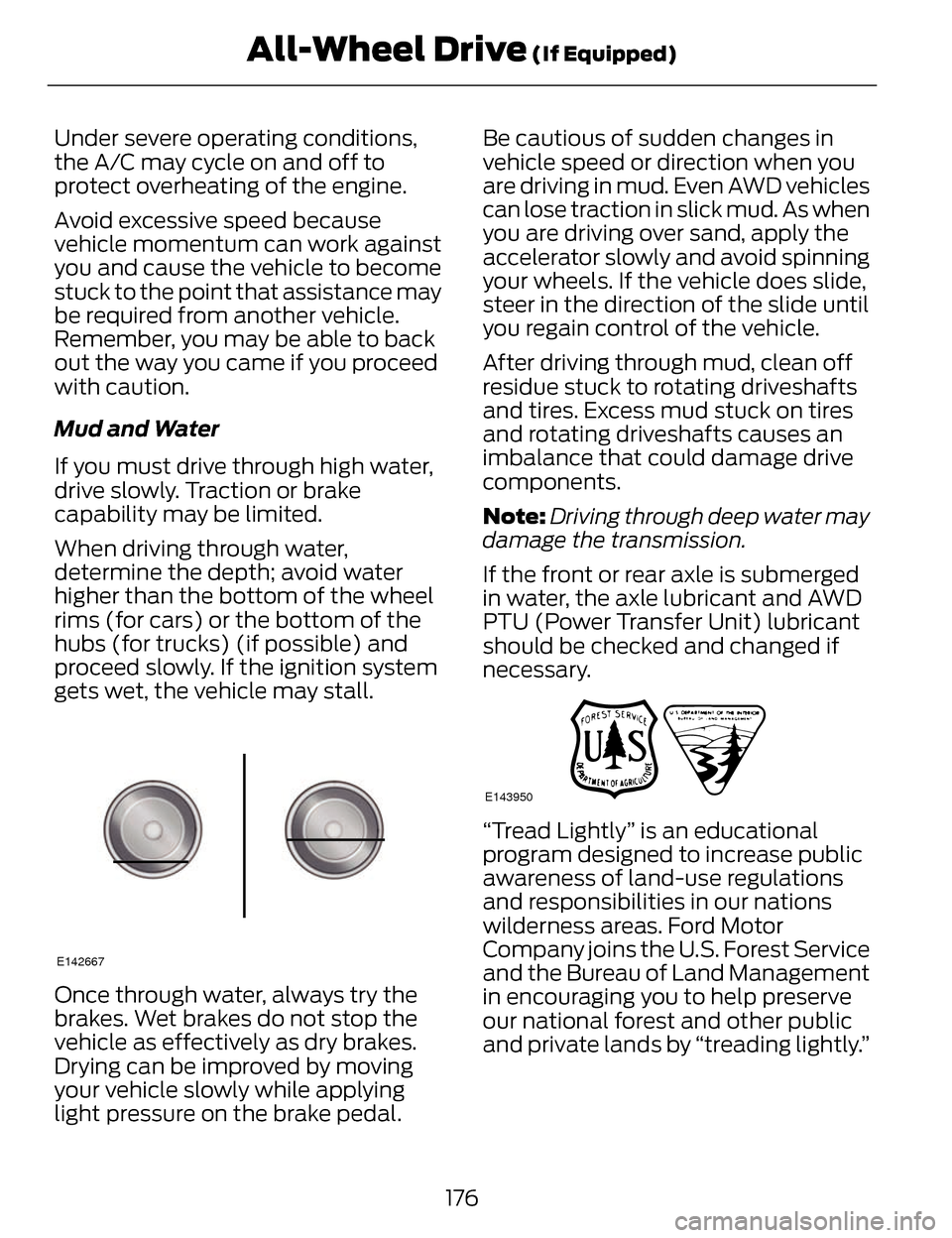
Under severe operating conditions,
the A/C may cycle on and off to
protect overheating of the engine.
Avoid excessive speed because
vehicle momentum can work against
you and cause the vehicle to become
stuck to the point that assistance may
be required from another vehicle.
Remember, you may be able to back
out the way you came if you proceed
with caution.
Mud and Water
If you must drive through high water,
drive slowly. Traction or brake
capability may be limited.
When driving through water,
determine the depth; avoid water
higher than the bottom of the wheel
rims (for cars) or the bottom of the
hubs (for trucks) (if possible) and
proceed slowly. If the ignition system
gets wet, the vehicle may stall.
E142667
Once through water, always try the
brakes. Wet brakes do not stop the
vehicle as effectively as dry brakes.
Drying can be improved by moving
your vehicle slowly while applying
light pressure on the brake pedal.Be cautious of sudden changes in
vehicle speed or direction when you
are driving in mud. Even AWD vehicles
can lose traction in slick mud. As when
you are driving over sand, apply the
accelerator slowly and avoid spinning
your wheels. If the vehicle does slide,
steer in the direction of the slide until
you regain control of the vehicle.
After driving through mud, clean off
residue stuck to rotating driveshafts
and tires. Excess mud stuck on tires
and rotating driveshafts causes an
imbalance that could damage drive
components.
Note:
Driving through deep water may
damage the transmission.
If the front or rear axle is submerged
in water, the axle lubricant and AWD
PTU (Power Transfer Unit) lubricant
should be checked and changed if
necessary.
E143950
“Tread Lightly” is an educational
program designed to increase public
awareness of land-use regulations
and responsibilities in our nations
wilderness areas. Ford Motor
Company joins the U.S. Forest Service
and the Bureau of Land Management
in encouraging you to help preserve
our national forest and other public
and private lands by “treading lightly.”
176
All-Wheel Drive (If Equipped)
Page 180 of 468
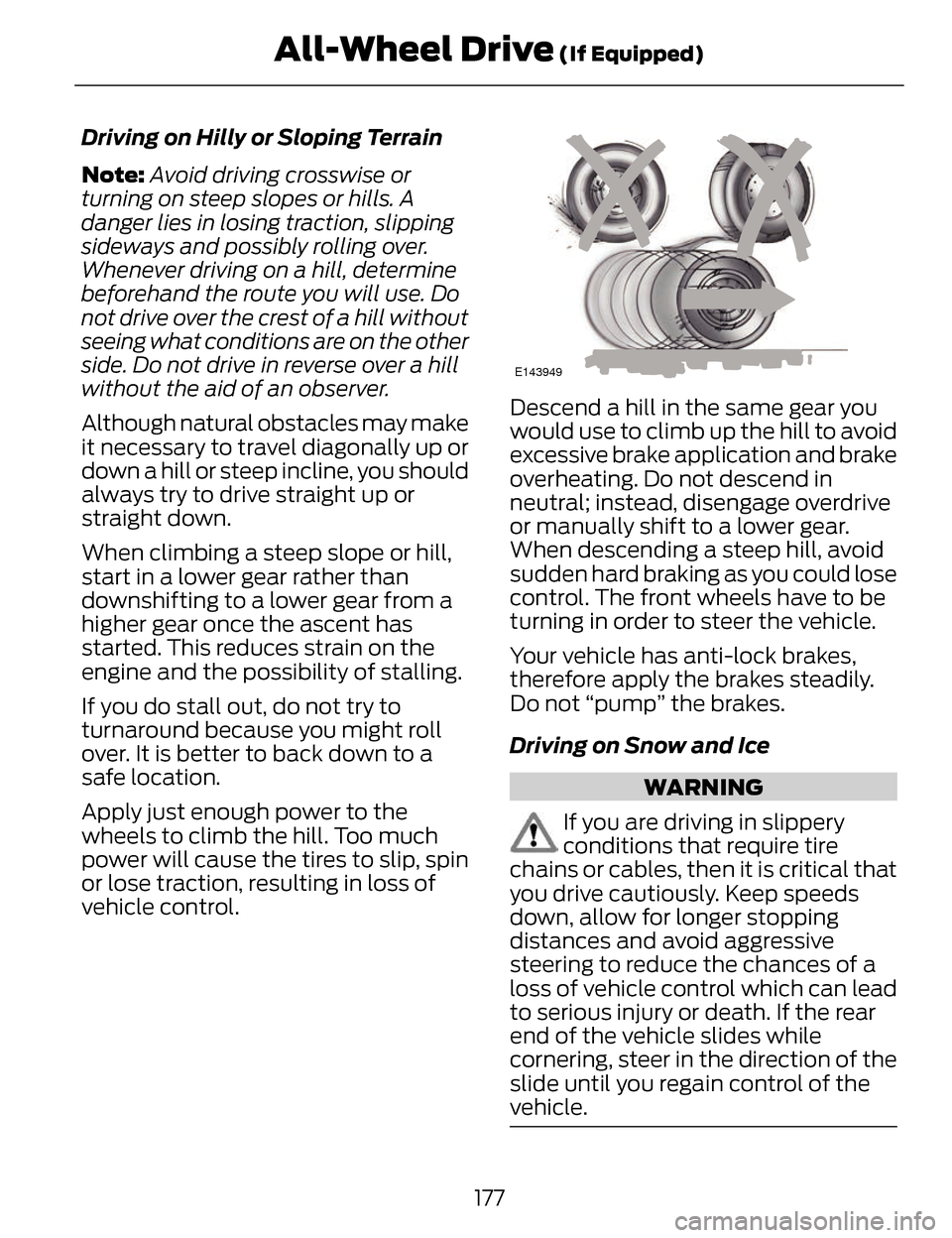
Driving on Hilly or Sloping Terrain
Note:Avoid driving crosswise or
turning on steep slopes or hills. A
danger lies in losing traction, slipping
sideways and possibly rolling over.
Whenever driving on a hill, determine
beforehand the route you will use. Do
not drive over the crest of a hill without
seeing what conditions are on the other
side. Do not drive in reverse over a hill
without the aid of an observer.
Although natural obstacles may make
it necessary to travel diagonally up or
down a hill or steep incline, you should
always try to drive straight up or
straight down.
When climbing a steep slope or hill,
start in a lower gear rather than
downshifting to a lower gear from a
higher gear once the ascent has
started. This reduces strain on the
engine and the possibility of stalling.
If you do stall out, do not try to
turnaround because you might roll
over. It is better to back down to a
safe location.
Apply just enough power to the
wheels to climb the hill. Too much
power will cause the tires to slip, spin
or lose traction, resulting in loss of
vehicle control.
E143949
Descend a hill in the same gear you
would use to climb up the hill to avoid
excessive brake application and brake
overheating. Do not descend in
neutral; instead, disengage overdrive
or manually shift to a lower gear.
When descending a steep hill, avoid
sudden hard braking as you could lose
control. The front wheels have to be
turning in order to steer the vehicle.
Your vehicle has anti-lock brakes,
therefore apply the brakes steadily.
Do not “pump” the brakes.
Driving on Snow and Ice
WARNING
If you are driving in slippery
conditions that require tire
chains or cables, then it is critical that
you drive cautiously. Keep speeds
down, allow for longer stopping
distances and avoid aggressive
steering to reduce the chances of a
loss of vehicle control which can lead
to serious injury or death. If the rear
end of the vehicle slides while
cornering, steer in the direction of the
slide until you regain control of the
vehicle.
177
All-Wheel Drive (If Equipped)